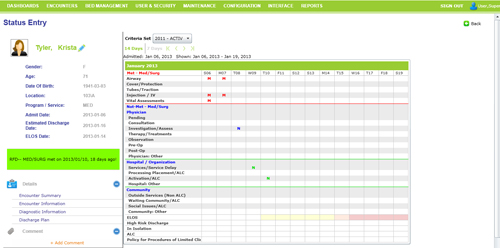Clinical Flow system helps teams focus on common goal
Communication, safety, patient flow enhanced
Quality health care relies on the constant exchange of information. Having an updated decision support tool will help professional teams maintain their focus on the goals of stay for hospitalized patients, while improving information sharing.
Medworxx, clinical patient care software, captures the reasons for a person's hospital stay. This real-time information can be seen on an overview screen (see mock screen shot below). With daily updates made by a registered nurse, a person's most recent health goals, progress or barriers are identified - and shared with the person's multidisciplinary health care team. This collaborative dialogue helps to ensure the person is receiving the right care in the right place at the right time.
This sample profile offers a glimpse at what the program offers (click to enlarge)
"This allows our professional staff to better help our public access services," says Trish Bergal, Regional Director Patient Access and Transition Support. "Teams can identify transition gaps that are integral to good, quality safe care with a tactical tool that encourages staff to critically examine the goals for care, and what is needed to move the patient forward in their hospital stay. The information in the Medworxx Clinical Flow system supports important conversations among our team and between the team, the patient and their support system."
The software helps track, and minimize avoidable days of stay in hospital. Those could be when orders haven't been followed, there may be a delay on a consult, or a person might better benefit from an alternative level of care, or receiving care in a different way.
Being aware of these delays can help reduce days of stay in hospital. With a system goal of reducing in-patient occupancy, a positive impact would then be a reduction in the length of time a person is in the emergency department waiting admission to an in-patient bed.
Reasons why a person is in an acute care facility - instead of receiving care in other settings - is information that from a systemic planning perspective helps the organization direct services, says Bergal.
"Staff can quickly see an overview of all the patients on their unit and why they are still in hospital. There is strong support in the literature that longer lengths of stay in hospital can actually have a negative impact on patient outcomes - such as developing infections, becoming deconditioned, being at risk for falls. So having a logistical tool that helps keep the team focused on the action items to reach the necessary patient goals of stay is of great value," says Bergal. "You can track a person's progress and re-evaluate the goal daily."
With an aging population, greater complexity and acuity in their health issues, demands on admission within the health care system are at an all-time high. With known anticipated demands on admission, the solution is not to build more acute hospital beds, but rather to expand our community programming to support people in the most suitable care environment, whether that is home or some form of supported housing in the community.
While the Medworxx software has been in place in the Winnipeg Health Region for 10 years, the latest version is web-based and has many new features. The timing is right for new and improved technology and compliments other flow improvement tools that are being introduced in the Region, such as Oculys, an electronic bed management system.
All of these new clinical flow tools represents an opportunity for health care teams and registered nurses to maximize their scope of practice. For instance, within the registered nursing profession, not only are nurses more comfortable with technology and computers than they were even 10 years ago, using the program as a tool for logical patient access and transition is a long way from regarding it as an area to enter data.
"Professional standards of practice require registered nurses and other members of the health care team to stay current with medical technology that supports effective, safe and ethical patient care," says Laura Anning, Regional Specialist with Patient Access and Transition Support.
Having this software region-wide in acute care facilities helps standardize processes. It also provides important information to share as a team in patient huddles on the unit, and can help everyone work more collaboratively regarding discharge. Ultimately, the people we care for benefit with safer, quality care and improved flow through the system.
Fast facts
- Medworxx is being used in 72 patient care units across the Winnipeg Health Region.
- Six acute care sites are using the Medworxx Patient Flow System: Concordia Hospital, Grace Hospital, Health Sciences Centre, St. Boniface Hospital, Seven Oaks General Hospital and the Victoria General Hospital.
- There are about 1800 Medworxx users.
- The program areas that are use the Medworxx Patient Flow System are adult medicine and surgery, adult mental health, rehab geriatrics, child health medicine and surgery, and child and adolescent mental health
- Based on information entered into the Medworxx Patient Flow System we know the following:
- The most popular reason for hospitalization in acutely ill people is for treatment and intervention for airway management, care of intravenous and other newly inserted tubes, and close vital sign monitoring.
- The most popular reason for hospital stay for people who are improving in their condition but remain in hospital do so to regain functional recovery.
- The most frequent reason for stay in hospital for people who require an alternative level of care is waiting to access a long term care bed.
- The average hospital bed days for patients who are waiting transfer to rural Manitoba is 50 days per month.

